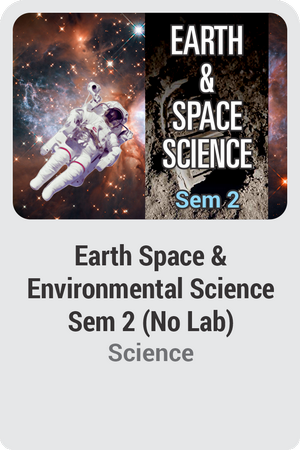
Course Overview:
Students study about the importance of our environment – the factors affecting it and why it’s important to carefully watch it. The course delves into the effect of environmental degradation on ecosystems and biodiversity – and the impact on humans. They also learn about the political factors affecting environment sanity and the need to carefully evaluate the benefits vs. tradeoffs for various commercial activities.
Note: This course is not designed for ELL (English Language Learners) students. ELL students may enroll in this course ONLY if they have adequate mentor support at their home school and are able to fulfill all course requirements.
Prerequisites:
Middle School ScienceSyllabus:
Section 1: Introduction
Objectives:
- Introduction to Science
- Collecting & Measuring Data
- Introduction to Environmental Science
- How Ethical beliefs affect the global climate and the efforts to aid reverse global warming like Going Green
- How personal Ethics affects the Environment
- Careers in Environmental Science
Lessons:
- Introduction to Science
- Data and Its Measurement
- Representing Data
- Introduction to Environmental Science
- Human Impact on the Environment
- Global Warming and Going Green
- Careers in Environmental Science
Section 2: The Science Behind Environmental Science
Objectives:
- The Foundations of Environmental Science
- Thinking from a System’s Perspective
- Introduction to the Concept of Energy
- Laws of Conservation of Energy
Lessons:
- Foundations of Environmental Science
- Systems Thinking
- Energy in Environmental Science
- Mechanical & Thermal Energy
- Conservation of Energy
Section 3: Biology & Environmental Science
Objectives:
- Populations and their dynamics
- Factors that affect biodiversity
- Sustainable practices & their implementation
- Global warming and its impact on the Environment
Lessons:
- Population Dynamics
- Biodiversity and Population Growth
- Sustainability
- Global Warming
Section 4: Case Studies
Objectives:
- What is DDT and what impact did DDT have on the Environment?
- Rachel Carson’s “Silent Spring” and its impact on policy
- Environmental issues related to the marine world
- What is MPRSA and how did it affect the wellbeing of the marine world?
Lessons:
- DDT
- Rachel Carson’s Silent Spring
- Protecting Our Marine World
- Impact of MPRSA
Section 5: Politics, Policy, Ethics & Leaders
Objectives:
- Which countries pollute the most and which countries suffer as a result
- How can countries make the environment a priority
- The role politics plays when it comes to environmental protection
- The role economics plays when it comes to environmental protection
- What can happen when our ethics guide our policies on the environment
- What role does the EPA play in the United States
- What are some of the key environmental initiatives pursued by various countries
- Who are some leaders who are risking their lives to protect the environment
Lessons:
- Who Pollutes, Who Pays
- Making Environment a Priority
- The Politics of Environmental Protection
- Economics & The Environment
- Ethics & The Environment
- Role of the EPA
- Environmental Initiatives
- Thought Leaders


